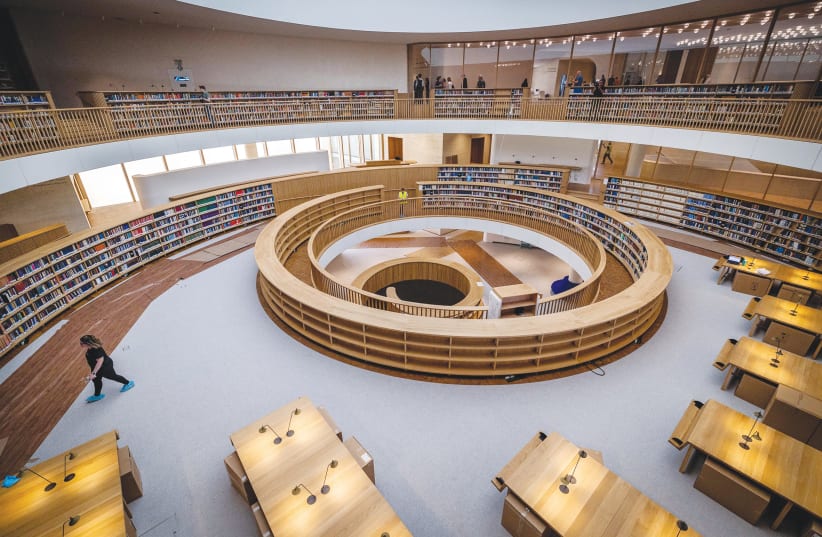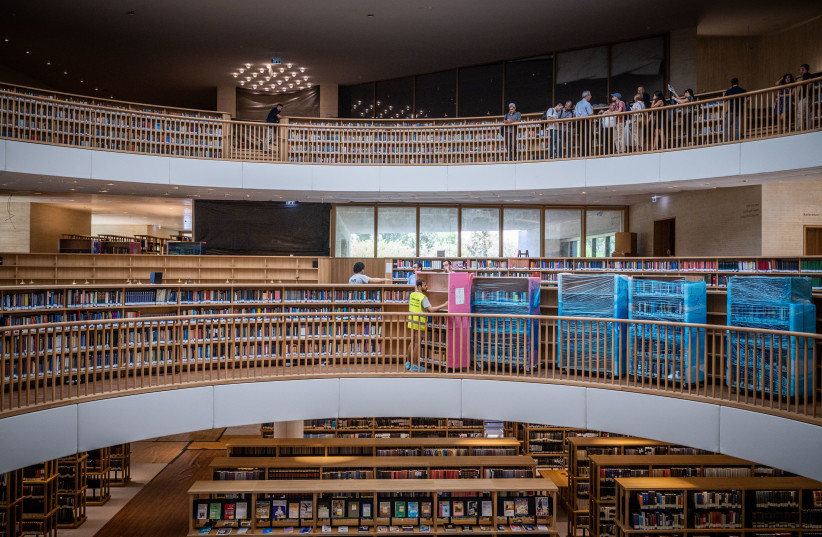For the better part of the previous decade, I walked past the construction site of the new National Library building on Ruppin Street in Jerusalem, which was on the track of my weekly walk.
Progress on the building was very slow. What was most noticeable was the fact that experiments were constantly being made with the setting of the blocs of stone designated for the exterior walls.
Many buildings in Jerusalem are covered with Jerusalem stone, but the Swiss architects of the library building – Jacques Herzog and Pierre de Meuron – preferred a stone excavated in Mitzpe Ramon in the Negev, that is much whiter than the pinkish Jerusalem stone. The final result, even though relatively humble for such a central building, is pleasant to behold.
I also noticed that it took several years until the vast concave roof – with a transparent section in the middle – was completed, and I kept wondering how the roof would fare in rainy winters. Last week, when I ventured for the first time into the building that was inaugurated, almost secretly, at the beginning of November, the first question I asked several members of the staff sitting in the various reading rooms was whether during the recent heavy rain in Jerusalem there had been any leaks from the ceiling. Some whispered in response, that indeed, several leaks had been observed.
Clearly, the outbreak of the war against Hamas interfered with the original plan to hold a grand event for the library’s inauguration. However, even though I live a mere 15 minutes walking distance from the library’s location, I was not aware of the actual opening until I saw a long article about the building, accompanied by numerous photographs.
The calmest and most peaceful structure in town
I decided that there was no better form of escapism from all the emotional twists, turns, and horrors of the war that we keep hearing about from all the media outlets, and no better thing to do on a sunny autumn morning, than to take a walk to what must be the calmest and most peaceful structure in town, and to catch a first glimpse of its interior.
I entered from the bottom entrance of the Library on Ruppin Street, on the -2nd floor. To the left, through one of many glass walls inside the building, one can observe the lowest reading room – which currently displays a set of chairs, with the names and photographs of the hostages, and suitable books laid on each chair. In the past few days several chairs could be removed – but it will still be a lengthy process.
At the entrance, I was told to deposit my bag and coat in the cloakroom, on the top floor, close to the entrance from Kaplan Street. Unfortunately, none of the main elevators on the southeastern side of the building were operating, and I had to walk up a vast, rounded, asymmetrical staircase to reach the cloakroom. Later I discovered a smaller elevator that is in use and a simpler staircase on the north-western side of the building.
Much more difficult was to figure out how to move between the various spaces on the same floor. For example, the only way I could get from the top reading room back to the cloakroom on the same floor was to walk through a space that apparently serves the guided tours of the library and is currently adorned by photographs of all the fallen soldiers of the war against Hamas, the door into which has signs saying “no entry,” and “security door.”
The single alternative is to walk down the northwestern staircase, and then somehow find another staircase (or elevator) back up to the southeastern side of the top floor. I opted for the “no entry” door, my excuse being that though as a child I loved running up and down staircases, at the age of 80 I am a little less enthusiastic about this activity.
Calm magnificence
AS ONE starts roaming the library, one is struck by the calm magnificence of the building and its soft coloration. All the spaces are well-lit by a combination of natural light and electric bulbs. The woodwork – such as shelves, desks, and banisters – is made of light-colored, polished wood. The reading rooms and spaces are spacious and can accommodate a total of up to 600 readers.
During my visit, the library was far from full, but all sections of the population seemed to be represented, including at least one haredi man. What I could not find were dark, secluded corners, of the sort I had always preferred to occupy in libraries back in my student days. Apparently, the architects of modern libraries believe in open spaces, and even if they do provide some small corners, they are well-lit. As required by law, safe, protected areas are provided on every floor, but those I saw were completely bare.
Most of the library’s books are to be found in six underground stories of stacks, from which books are brought up to the readers by mechanical means. The stacks in the old building – on the Hebrew University Givat Ram campus until several weeks ago – were handled manually.
More frequently used books are arranged by subject on shelves throughout the reading rooms. During the day, most of the lighting in the center of each floor comes from an elliptical-shaped transparent ceiling and underneath is a cone-shaped void, surrounded on each floor by banisters.
The void spaces become smaller as one moves to the lower floors. If one stands by the banisters one can observe the floors above and below. The only problem is that one must walk down several steps to reach the banisters, and there is a danger of missing the steps, and tripping.
I recall that when the original Knesset building was constructed in Givat Ram, in the first half of the 1960s, the plan for the plenary hall was to have natural light coming in from windows constructed below the edges of the solid ceiling.
However, the light that penetrated was not sufficient, the windows were blocked, and much stronger electric lighting was introduced. A transparent ceiling is apparently a much better solution, even though I was told that when it rains one can hear the raindrops hitting the transparent roof.
It should be noted that many of the designated spaces within the library are not yet operable, such as a 480-seat auditorium, named after philanthropist David Geffen, that will host concerts, conferences, lectures, film screenings, and performances; an activity center for children; a permanent exhibition hall; and a cafeteria (at the moment only a small snack bar is available).
Like many other public buildings in Israel, the national library houses numerous artworks specially created for it, of which I saw only a few, but which I shall seek out on my next visit. I was only wondering whether there is any chance that the magnificent stained-glass windows, created by Mordechai Ardon for the old National Library building in 1984, might find a new home in the new building. However, the deep colors of the windows might make it hard to find a suitable corner for them, in a building that prides itself in its soft coloration.
The writer worked in the Knesset for many years as a researcher and has published extensively both journalistic and academic articles on current affairs and Israeli politics. Her most recent book, Israel’s Knesset Members – A Comparative Study of an Undefined Job, was published by Routledge last year.

